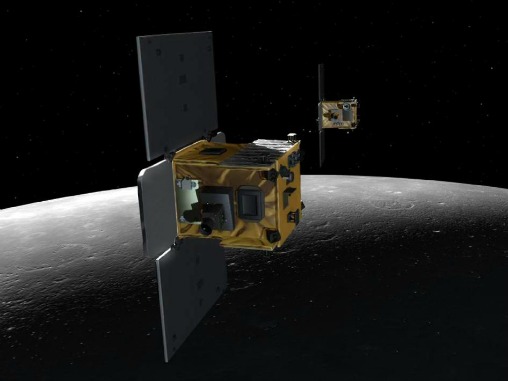NASA engineers rarely clap and cheer when their spacecraft crash. That wasn't the case today.
Nearly one year after beginning to orbit the moon and helping scientists learn more about the internal structure andcomposition of the moon, NASA's twin spacecraft, named Ebb and Flow, crashed into the Moon late Monday afternoon -- just as planned.
The impact marked an end to a NASA-driven mission to not only give scientists more information about how the moon was formed, but also to send back more than 100,000 images for U.S. middle school students to study in class.
Last Friday, scientists directed the spacecraft to move into a lower moon orbit that would eventually pull them into the moon's surface.

GRAIL spacecraft over the moon. Image: NASA
Ebb and Flow both crashed into a mountain on the moon's north pole. Traveling at a speed of 3,760 mph, they hit one after another at 5:28 p.m. ET and 5:29 p.m. ET.
Since the orbiters did not have sufficient altitude or fuel to continue scientific operations, engineers decided to end their mission by crashing the orbiters onto the lunar surface.
"We will miss our lunar twins, but the scientists tell me it will take years to analyze all the great data they got, and that is why we came to the moon in the first place," said GRAIL project manager David Lehman. "So long, Ebb and Flow, and we thank you."
NASA announced that the mission, dubbed GRAIL for Gravity Recovery and Interior Laboratory, was a success, giving them the highest resolution gravity field map of any celestial body.
The map will provide a better understanding of how earth and other rocky planets in the solar system formed and evolved.
"It is going to be difficult to say goodbye," GRAIL principal investigator Maria Zuber of MIT said in a written statement. "Our little robotic twins have been exemplary members of the GRAIL family, and planetary science has advanced in a major way because of their contributions."
Engineers have named the crash site after Sally K. Ride, who was America's first woman in space and a member of the probes' mission team.
"Sally was all about getting the job done, whether it be in exploring space, inspiring the next generation, or helping make the GRAIL mission the resounding success it is today," said GRAIL principal investigator Maria Zuber of MIT. "As we complete our lunar mission, we are proud we can honor Sally Ride's contributions by naming this corner of the moon after her."
Along with its primary science instrument, each orbiter carried a camera that took more than 115,000 images of the lunar surface. Before the mission began, groups of middle school students voted on what areas of the moon the cameras should target. The images are being sent to those students as part of the planetary studies program.
"Sally Ride worked tirelessly throughout her life to remind all of us, especially girls, to keep questioning and learning," said Sen. Barbara Mikulski (D.-Md). "Today her passion for making students part of NASA's science is honored by naming the impact site for her."
Launched in September 2011, Ebb and Flow had been orbiting the moon since Jan. 1.





